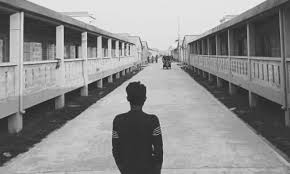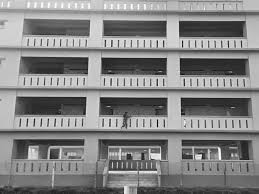‘There Is No Noise’: Inside the Controversial Rohingya Bhasan Char Refugee Camp – A Photo Essay
ASIA-UPDATES ON MYANMAR ROHINGYA GENOCIDE, 18 Jan 2021
Anonymous, as told to Shafiur Rahman | The Guardian - TRANSCEND Media Service
Amid concern from charities and NGOs, Bangladesh is relocating Rohingya refugees to a remote island. One resident describes his new life there.
11 Jan 2021 – The photographs from inside the oddly eastern European-looking accommodation on Bhasan Char, the swampy island being used by the Bangladeshi government to house Rohingya people, were taken by one of the refugees living there. We couldn’t publicly identify the photographer, or credit them with their rightful byline on the pictures, and that speaks volumes about the vulnerability of the Rohingya, whose activism and smart use of journalistic tools have helped keep their plight in the public eye, but who are now facing forceful arrest as the Bangladeshi authorities clamp down on such activities.
And on the subject of covering stories with the help of the people at their heart, I was really pleased to be able to run the thoughtful opinion piece co-written by Dedo Baranshamaje and Katie Bunten-Wamaru talking about how we still have this heavy, western, we-know-best slant in how we help poorer countries. The statistic that 99% of all aid money goes to white-led international organisations is truly shocking. In the US, less than 6% of charitable foundations’ funding goes to African-led initiatives. That points not only to devastatingly systematic racism, but also a deep disconnect between how money is spent – and how it would best be spent.
— Tracy McVeigh, editor, Global development

‘This is the main street in my cluster. There are three TomToms. They haul stuff for the navy. Not for the refugees.’ Photograph: Anonymous
I wanted to come here. No one forced me, and my wife also agreed in a snap.
To be honest, though, I didn’t tell my brother. He lives where I used to live – Kutupalong camp. He is very against this island for some reason. He might have tried to stop me coming if I dared to discuss the topic. So I didn’t. I only told him after I arrived. I was amazed that he didn’t yell at me.
Instead he wondered if he would ever see me again and even got a bit emotional.
Now when we phone each other, we compare facts and figures. On the island, we get 15kg of rice per head. They get only 13kg in the camps. We get 500g more dal and 1kg more potatoes here too. I am winning so far in our comparisons. We have been here just over one month. We are getting used to it.
For some reason, I don’t sleep properly. When I lie awake, in the dead of night, I can hear the sea and sometimes the horn of berthing ships. I feel a bit strange then but by the morning that feeling goes away. My children ask if their little friends from our neighbourhood back in the camp will come to the island. I really don’t know what to tell them. I guess they will find new friends here soon when their school starts.
There are tall buildings here. Refugees are not permitted in upper floors. Maybe they think we will kill ourselves?
There are a lot of children here, and when they play and get noisy it makes this island feel better, to tell you the truth –and less abnormal. The buildings are all the same here. We live on the ground floor. There are some tall buildings. Refugees are not permitted on the upper floors. Maybe they think we will kill ourselves?
TO CONTINUE READING/VIEWING Go to Original – theguardian.com
Tags: Asia, Aung San Suu Kyi, Bangladesh, Bhasan Char refugee camp, Buddhism, Burma/Myanmar, Cultural violence, Direct violence, Ethnic Cleansing, Free Rohingya Coalition, Genocide, History, Human Rights, Institute on Statelessness and Inclusion, International Court of Justice ICJ, Justice, Maung Zarni, Racism, Religion, Rohingya, Social justice, Structural violence, Tendayi Achiume, United Nations, Yanghee Lee
DISCLAIMER: The statements, views and opinions expressed in pieces republished here are solely those of the authors and do not necessarily represent those of TMS. In accordance with title 17 U.S.C. section 107, this material is distributed without profit to those who have expressed a prior interest in receiving the included information for research and educational purposes. TMS has no affiliation whatsoever with the originator of this article nor is TMS endorsed or sponsored by the originator. “GO TO ORIGINAL” links are provided as a convenience to our readers and allow for verification of authenticity. However, as originating pages are often updated by their originating host sites, the versions posted may not match the versions our readers view when clicking the “GO TO ORIGINAL” links. This site contains copyrighted material the use of which has not always been specifically authorized by the copyright owner. We are making such material available in our efforts to advance understanding of environmental, political, human rights, economic, democracy, scientific, and social justice issues, etc. We believe this constitutes a ‘fair use’ of any such copyrighted material as provided for in section 107 of the US Copyright Law. In accordance with Title 17 U.S.C. Section 107, the material on this site is distributed without profit to those who have expressed a prior interest in receiving the included information for research and educational purposes. For more information go to: http://www.law.cornell.edu/uscode/17/107.shtml. If you wish to use copyrighted material from this site for purposes of your own that go beyond ‘fair use’, you must obtain permission from the copyright owner.
Read more
Click here to go to the current weekly digest or pick another article:
ASIA-UPDATES ON MYANMAR ROHINGYA GENOCIDE:
